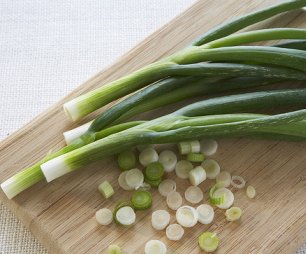Cong Bai

  | Cong Bai in TCM:Explore the properties of Cong Bai according to Chinese
Nutrition and Traditional Chinese Medicine (TCM):
Factoids:
English Name: allium, scallion, green onion
Pharmacuetical Name: Bulbus Allii Fistulosi
Properties: acrid, warm
Temperature: warm
Channels: LU, ST
Flavors: pungent
Special Properties:
disperses cold, eliminates toxins, disperses wind, reduces swelling
Actions / Indications:
- Releases exterior; induces sweating (for early stage
wind-cold; can cook with ginger to make a tea or with rice for food)
- Disperses cold; unlock yang (abdominal pain, distension;
nasal congestion due to cold-blocked yang qi)
- Relieves Toxicity; disperses clumps (aids lactation
by unblocking breasts; for sores and abcesses: used externally as poultice)
Special Notes:
- (cooking: add near the end of the decoction)
- Cong Bai as a topical paste with Sheng Jiang
and salt was used to treat common cold with marked results. Paste was
applied to chest, back, soles, palms, and popliteal fossa for 1 to 2
days.
Contraindications:
- (cc: caution for deficiency with sweating)
- (cc: according to some sources, do not use with honey when taken orally)
Disclaimer: In accordance with our terms of service, by using this web site you agree that none of the information found on this web site constitutes medical advice. You should always consult your doctor before trying any particular food or herbal remedy to treat disease.
Folk remedies presented on this site are designed to address specifc TCM diagnoses, and are not one-size-fits-all. If you would like to learn more about Traditional Chinese Medicine (TCM) and how it relates to Chinese Nutrition, you can book in a free call with a licensed professional. There is no obligation to purchase.
[CLICK HERE for your free INITIAL CONSULTATION] |

